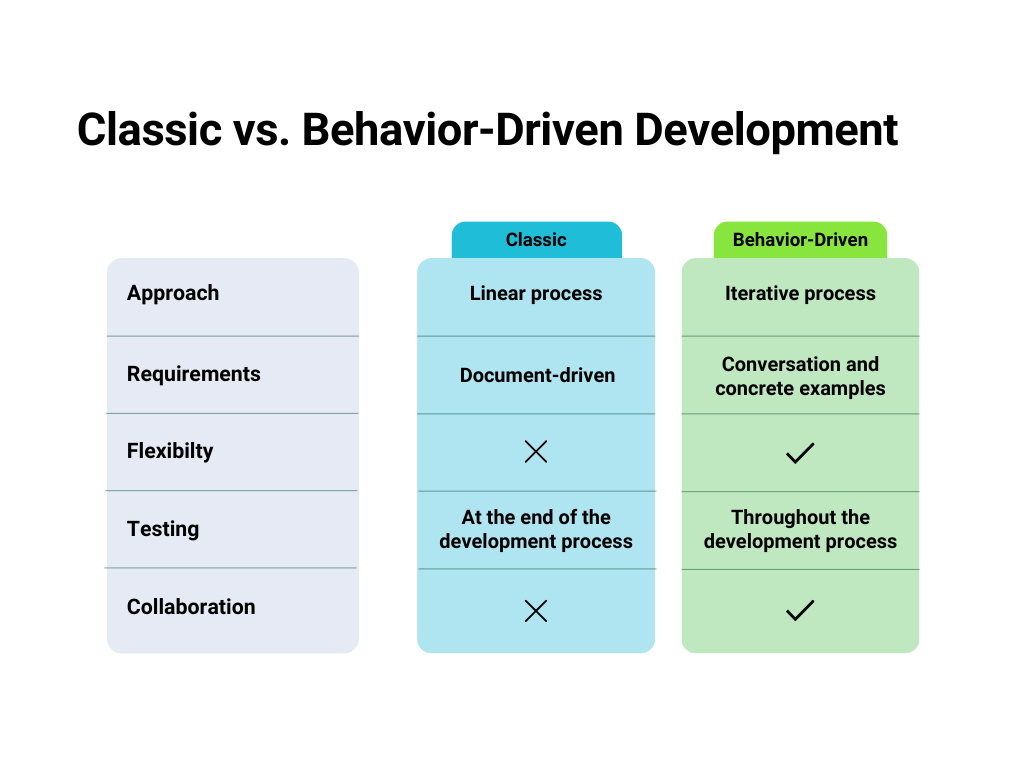
Author: Kysha Praciak
· 4 mins read · 784 views
Classic vs. Behavior-Driven Software Development
Introduction
In the fast-paced world of software development, there are various methodologies and approaches that developers can choose from. Two popular ones are classic software development and behavior-driven development. Each of these methodologies has its own set of advantages and disadvantages. In this article, we will explore the differences between classic software development and behavior-driven development, and discuss which approach may be better suited for different scenarios.
Classic Software Development
Classic software development, also known as the traditional or waterfall model, is a sequential approach to software development. In this methodology, the development process is divided into distinct phases, such as requirements gathering, design, implementation, testing, and maintenance. Each phase must be completed before moving on to the next, and changes made at later stages can be time-consuming and costly.
Advantages of Classic Software Development
- Simplicity: The linear nature of classic software development makes it easy to understand and follow. This can help in planning and estimating project timelines and resources.
- Clear roadmap: Classic software development provides a clear roadmap for the development team, as they know exactly what needs to be done at each stage.
- Well-established: Classic software development is a well-established methodology with a long history of successful projects. Many developers and organizations are familiar with its principles and processes.
Disadvantages of Classic Software Development
- Lack of flexibility: Once a phase is completed, it is difficult to go back and make changes without disrupting the entire process. This can lead to delays and inefficiencies, especially if requirements change or new features need to be added.
- Late detection of issues: The testing phase is typically conducted at the end of the development cycle, which can result in late detection of bugs and issues. This can lead to additional time and effort spent on bug fixing and rework.
- Limited customer involvement: Classic software development often has limited customer involvement during the development process. This can lead to misalignment between the final product and customer expectations.
Behavior-Driven Development
Behavior-driven development (BDD) is a software development methodology that focuses on collaboration and communication between developers, testers, and business stakeholders. BDD aims to bridge the gap between technical and non-technical team members by using a common language to describe the desired behavior of the software.
Advantages of Behavior-Driven Development
- Collaboration: BDD emphasizes collaboration between developers, testers, and business stakeholders, leading to a shared understanding of requirements and goals.
- Early issue detection: By writing tests that describe the desired behavior of the software, BDD allows for early detection of issues, resulting in quicker bug resolution and a more robust final product.
- Improved customer satisfaction: BDD focuses on delivering software that meets customer expectations by involving them in the development process. This can lead to increased customer satisfaction and reduced rework.
Diadvantages of Behavior-Driven Development
- Learning curve: BDD introduces a new way of thinking and requires a shift in mindset for developers and testers. This can result in a learning curve and initial resistance to change.
- Time-consuming: Writing comprehensive behavior-driven tests can be time-consuming, especially for complex software projects. This can impact project timelines and resources.
- Dependency on collaboration: BDD heavily relies on collaboration between team members. If there are communication gaps or conflicts within the team, the effectiveness of BDD can be compromised.

Which is Better and Why?
The choice between classic software development and behavior-driven development depends on various factors, including the nature of the project, the team dynamics, and the customer requirements. There is no one-size-fits-all answer to which approach is better, as both have their strengths and weaknesses.
- Classic software development may be more suitable for projects with well-defined and stable requirements, where changes are unlikely to occur frequently. It can also be a good choice when there is a need for a clear roadmap and a predictable timeline.
- On the other hand, behavior-driven development is a better fit for projects that require frequent changes, have evolving requirements, or involve a high level of collaboration between team members and stakeholders. BDD can help in delivering software that meets customer expectations and is more adaptable to changing needs.
Ultimately, the choice between classic software development and behavior-driven development should be based on a careful evaluation of the project requirements, team dynamics, and customer expectations.
Conclusion
In conclusion, classic software development and behavior-driven development are two distinct methodologies with their own set of advantages and disadvantages. Classic software development provides a simple and well-established approach, but lacks flexibility and may result in late issue detection. Behavior-driven development, on the other hand, promotes collaboration and early issue detection but requires a learning curve and can be time-consuming.
The choice between each should be made based on the specific needs of the project and the team dynamics. Both approaches have their merits and can be effective when applied in the right context. By understanding the strengths and weaknesses of each methodology, software development teams can make informed decisions to deliver high-quality software that meets customer expectations.
Looking for Expert IT Solutions?
Subscribe to Our Newsletter for Exclusive Tips and Updates!
Stay ahead of tech challenges with expert insights delivered straight to your inbox. From solving network issues to enhancing cybersecurity and streamlining software integration, our newsletter offers practical advice and the latest IT trends. Sign up today and let us help you make technology work seamlessly for your business!
Additional Resources:
References:
- Geeks for Geeks. 2024. Waterfall Model – Software Engineering. https://www.geeksforgeeks.org/waterfall-model/
- Agile Alliance. n.d. What is Behavior Driven Development (BDD). https://www.agilealliance.org/glossary/bdd/



Share